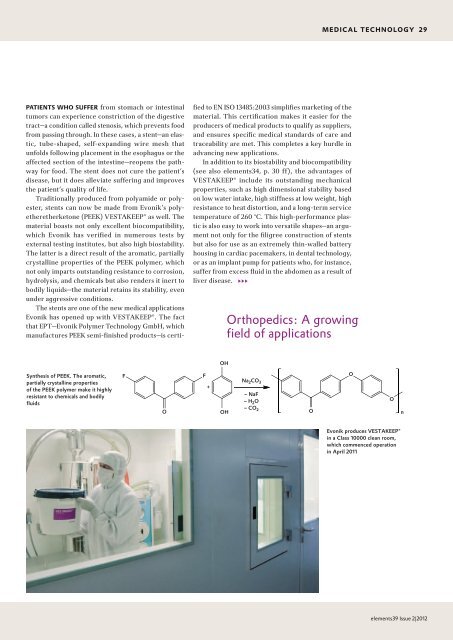Download - Evonik Industries
Download - Evonik Industries
Download - Evonik Industries
Create successful ePaper yourself
Turn your PDF publications into a flip-book with our unique Google optimized e-Paper software.
Patients Who suffeR from stomach or intestinal<br />
tumors can experience constriction of the digestive<br />
tract—a condition called stenosis, which prevents food<br />
from passing through. In these cases, a stent—an elastic,<br />
tube-shaped, self-expanding wire mesh that<br />
unfolds following placement in the esophagus or the<br />
affected section of the intestine—reopens the pathway<br />
for food. The stent does not cure the patient’s<br />
disease, but it does alleviate suffering and improves<br />
the patient’s quality of life.<br />
Traditionally produced from polyamide or polyester,<br />
stents can now be made from <strong>Evonik</strong>’s polyetheretherketone<br />
(PEEK) VESTAKEEP® as well. The<br />
material boasts not only excellent biocompatibility,<br />
which <strong>Evonik</strong> has verified in numerous tests by<br />
external testing institutes, but also high biostability.<br />
The latter is a direct result of the aromatic, partially<br />
crystalline properties of the PEEK polymer, which<br />
not only imparts outstanding resistance to corrosion,<br />
hydrolysis, and chemicals but also renders it inert to<br />
bodily liquids—the material retains its stability, even<br />
under aggressive conditions.<br />
The stents are one of the new medical applications<br />
<strong>Evonik</strong> has opened up with VESTAKEEP®. The fact<br />
that EPT—<strong>Evonik</strong> Polymer Technology GmbH, which<br />
manufactures PEEK semi-finished products—is certi-<br />
Synthesis of PeeK. the aromatic,<br />
partially crystalline properties<br />
of the PeeK polymer make it highly<br />
resistant to chemicals and bodily<br />
fluids<br />
fied to EN ISO 13485:2003 simplifies marketing of the<br />
material. This certification makes it easier for the<br />
producers of medical products to qualify as suppliers,<br />
and ensures specific medical standards of care and<br />
traceability are met. This completes a key hurdle in<br />
advancing new applications.<br />
In addition to its biostability and biocompatibility<br />
(see also elements34, p. 30 ff), the advantages of<br />
VESTAKEEP® include its outstanding mechanical<br />
properties, such as high dimensional stability based<br />
on low water intake, high stiffness at low weight, high<br />
resistance to heat distortion, and a long-term service<br />
temperature of 260 °C. This high-performance plastic<br />
is also easy to work into versatile shapes—an argument<br />
not only for the filigree construction of stents<br />
but also for use as an extremely thin-walled battery<br />
housing in cardiac pacemakers, in dental technology,<br />
or as an implant pump for patients who, for instance,<br />
suffer from excess fluid in the abdomen as a result of<br />
liver disease. 333<br />
Orthopedics: A growing<br />
field of applications<br />
F F<br />
+<br />
na2CO3 – naF<br />
– H2O O OH<br />
– CO2 O<br />
OH<br />
MedICAL teCHnoLoGY<br />
O<br />
O<br />
evonik produces veStAKeeP®<br />
in a Class 10000 clean room,<br />
which commenced operation<br />
in April 2011<br />
n<br />
29<br />
elements39 Issue 2|2012
















